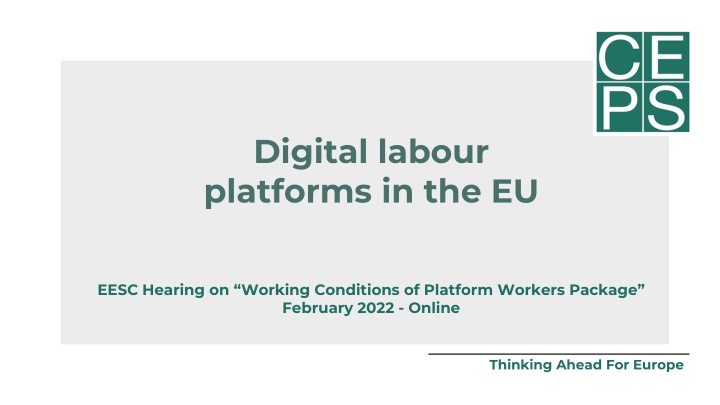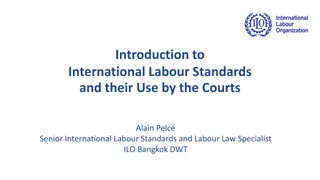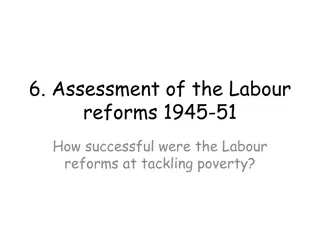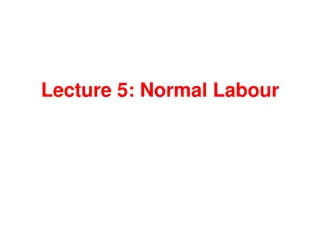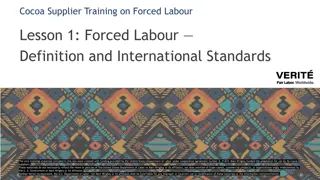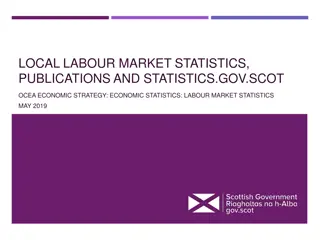Digital Labour Platforms in the EU: Overview & Trends
Digital labour platforms in the EU have seen significant growth in the past five years, with diverse activities and implications for worker employment status. The majority of platforms rely on self-employment agreements, impacting social protection and earnings security.
Download Presentation

Please find below an Image/Link to download the presentation.
The content on the website is provided AS IS for your information and personal use only. It may not be sold, licensed, or shared on other websites without obtaining consent from the author.If you encounter any issues during the download, it is possible that the publisher has removed the file from their server.
You are allowed to download the files provided on this website for personal or commercial use, subject to the condition that they are used lawfully. All files are the property of their respective owners.
The content on the website is provided AS IS for your information and personal use only. It may not be sold, licensed, or shared on other websites without obtaining consent from the author.
E N D
Presentation Transcript
Digital labour platforms in the EU EESC Hearing on Working Conditions of Platform Workers Package February 2022 - Online Thinking Ahead For Europe
Definition of digital labour platforms Source: Conceptualisation based on CEPS, EFTHEIA and HIVA-KU (2020). Digital labour platform (DLP): private internet-based company which intermediates, with greater or lesser extent of control, on-demand services requested by individual or corporate consumers. The services are provided directly or indirectly by natural persons, irrespective of whether such services are performed in the physical [on-location] or online world.
Size & activities of DLPs Size of DLP economy in EU (EUR billion) 15 14 DLPs economy increased almost fivefold in the past five years to EUR 14 billion in 2020 Platform revenues, platform worker revenues, and fourth party revenues Earnings of people working through platforms doubled to EUR 6 billion in 2020 Lower growth due to growing importance of delivery with lower share of work earnings An estimated three-quarters of the DLP economy originates from taxi and delivery platforms, but there are many different other types (freelancing, domestic work, home services, professional services, etc.) COVID-19 has had a significant impact on the activities of certain types of platform Move from taxi services to (food) delivery 13 11 3 10 8 1 5 8 6 4 5 3 1 8 3 1 3 2 3 1 2 1 1 0 1 0 0 0 0 0 2016 2017 2018 2019 2020 Earnings of people working through platforms in the EU (EUR billion) 7.5 7 Platform worker earnings (EUR bn) 6 0.7 6 0.5 0.4 5.0 4 2.4 3.7 0.2 3.2 3 2.6 2.5 0.0 1.2 1.5 1.0 1.1 1.5 0.9 0.8 0.6 0.4 0.2 0.1 0.4 0.4 0.3 0.3 0.2 0.0 2016 2017 2018 2019 2020 Freelance Delivery Home services Domestic work Microtask Taxi Contest-based Professional services Medical consultation
Employment status Proportion of people working as employees Share of number of DLPs 100% The business models of DLPs have important implications for the employment status 75% 50% The vast majority of DLPs position themselves as technology companies with an intermediating function, and rely on a crowd of independent, self- employed contractors to carry out services 25% 0% Domestic work Freelance Contest-based Taxi Delivery Professional services Microtask Home services Large majority of DLPs (92% of platforms and 93% of earnings) use self-employment agreements, whereas the remaining use work agreements (8% of platforms and 7% of earnings) All Online web-based platforms Location-based platforms Share of earnings of people working through DLPs 100% 75% A very small minority of DLPs employ all of their workers, all of whom provide location-based delivery work 50% 25% 0% Freelance Domestic work Delivery Taxi Professional services Contest-based Microtask Home services Classification as a self-employed worker is associated with a lack of social protection and secure earnings All Online web-based platforms Location-based platforms All Some None
Autonomy in allocation of tasks Share of number of DLPs 100% Working conditions assessed based on WES- model for 38 large and diverse DLPs across 52 countries (some on-location DLPs assessed for working conditions in up to 5 MSs) 75% 50% 25% 0% Domestic work Freelance Contest-based Taxi Delivery Professional services Microtask Home services Major challenge was to identify the working conditions as most DLPs do not disclose the working conditions to non-workers All Online web-based platforms Location-based platforms In practice, people working through platforms often have little autonomy in task allocation Share of earnings of people working through DLPs 100% 75% Particularly for low-skilled, offline work 50% 25% 0% Domestic work Freelance Taxi Delivery Professional services Contest-based Microtask Home services All Online web-based platforms Location-based platforms Low Medium High
Appraisal and use of algorithms Appraisal of people working through DLPs Share of number of DLPs 100% Another key element of the DLP business model is the use of algorithms for platform governance 75% 50% 25% Reliance on data for surveillance and appraisal by both platforms and clients 0% Freelance Domestic work Taxi Delivery Professional services Microtask Contest-based Home services This can have negative effects on working conditions Risk of account suspension/deactivation All Online web-based platforms Location-based platforms Share of earnings of people working through DLPs Refusal of payment 100% 75% High level of competition/stress 50% 25% Decisions are often untransparent and can be erroneous 0% Freelance Domestic work Taxi Delivery Professional services Contest-based Microtask Home services Potential bias in data All Online web-based platforms Location-based platforms Platform Clients Both clients and platform Co-workers
Dispute resolution Dispute resolution Share of number of DLPs 100% Terms and conditions are often opaque and change frequently 75% 50% 25% Lack of channels for dispute resolution 0% Domestic work Freelance Taxi Professional services Contest-based Delivery Microtask Home services All Online web-based platforms Location-based platforms Share of earnings of people working through DLPs 100% 75% 50% 25% 0% Freelance Domestic work Taxi Delivery Contest-based Microtask Professional Home services services All Online web-based platforms Location-based platforms No dispute resolution stipulated Human provided to review and reconsider decision Dispute resolution process arbitrated by a third party
Further reading Select references of our previous work on the platform economy: De Groen, W.P.; Kilhoffer, Z.; Westhoff, L.; Postica, D.; and F. Shamsfakhr (2021), Digital labour platforms in the EU: Mapping and business models , DG EMPL. CEPS, HIVA, EFTHEIA (2019), Study to gather evidence on the working conditions of platform workers , DG EMPL. De Groen, W.P.; Kilhoffer, Z; Lenaerts, K; and I. Mandl (2019), Employment and working conditions of selected types of platform work , Eurofound. De Groen, W.P.; Lenaerts, K.; Bosc, R. & F. Paquier (2017), Impact of digitalisation and the on-demand economy on labour markets and the consequences for employment and industrial relations , Study prepared at the request of the Employers Group of the European Economic and Social Committee. De Groen, W.P.; Maselli, I. & B. Fabo (2016), The Digital Market for Local Services: A one-night stand for workers? An example from the on-demand economy , CEPS Special Report, No. 133. De Groen, W. P. & I. Maselli (2016), The Impact of the Collaborative Economy on the Labour Market , CEPS Special Report, No. 138.
Thank you! Leonie WESTHOFF leonie.westhoff@ceps.eu DISCLAIMER The information and views set out in this presentation are those of the presenter and do not necessarily reflect the official opinion of the Commission. The Commission does not guarantee the accuracy of the data included in this presentation. Neither the Commission nor any person acting on the Commission s behalf may be held responsible for the use which may be made of the information contained therein. More information on the European Union is available on the Internet (http://www.europa.eu). Thinking Ahead For Europe
Origin of DLPs active in EU27 Share of number of DLPs There are at least 500 DLPs active in the EU27 Large majority of these DLPs are of EU27 origin (77%) Share of EU27 DLPs are about half when considering the earnings from the platforms (51%) In terms of earnings, the non-EU DLPs mostly have their origin in the US and UK (Uber, Uber Eats, Deliveroo, UpWork, etc.) Oceania (7 - 1%) Other (2 - 0%) Asia (9 - 2%) North America (61 - 12%) Other Europe (41 - 8%) EU27 (396 - 77%) Share of earnings of people working through DLPs Other (EUR 0.001bn - 0%) Oceania (EUR 0.1bn - 1%) Asia (EUR 0.1bn - 1%) Non-EU originated DLPs active in the EU27 Earnings of people working through DLPs 3.0 earnings (EUR bn) Platform worker North America (EUR 3bn - 42%) 2.5 2.0 1.5 1.0 0.5 EU27 (EUR 3bn - 51%) 0.0 Other US UK AU IL IN CH AR TR BR CA HK JP MY RU SV UA Europe (EUR 0.3bn - 5%)
ANNEX - Platform classification Majority of the DLPs active in the EU intermediates one service DLP intermediated services are very diverse, but most DLPs focus on on- location delivery services (34%), on- location work (24%) or other on-location services (32%) Based on the statistical sector classification most are active in transportation (38%) and administrative and support activities (32%) DLPs active in EU27 by type of service (COLLEEM) 225 200 Number of active DLPs 175 172 150 169 125 127 100 97 75 92 87 86 79 72 50 64 55 49 25 0 Online clerical and data-entry tasks Online professional services Online creative and multimedia work Online sales and marketing support work Online software development and technology work Online writing and translation work Online micro tasks Online interactive On-location personal transportation services On-location delivery services On-location domestic work Other on-location services services DLPs active in EU27 by sector (NACE) 225 Number of active DLPs 200 175 150 125 100 200 167 75 129 115 104 103 50 96 85 84 84 83 71 25 52 31 14 0 1 1 0 0 0 0
ANNEX - Platform classification Delivery of service Share of earnings of people working through DLPs Share of number of DLPs Nearly all the DLPs active in the EU intermediate on-location services, both online and combination of online and on-location are more exceptional Both (51 - 10%) Online (EUR 1bn - 9%) Both (EUR 0.2bn - 2%) Online (187 - 36%) On- location (EUR 6bn - 89%) On-location (278 - 54%) Skill level Share of earnings of people working through DLPs Share of number of DLPs All (26 - 5%) High (109 - 21%) High (EUR 0.4bn - 6%) All (EUR 0.3bn - 4%) Most DLPs active in the EU intermediate low-skilled tasks Medium-high (EUR 0.03bn Medium (EUR 0.1bn - 2%) Low- medium (EUR 1bn - 18%) Medium- high (45 - 9%) Low (255 - 49%) Medium (6 - 1%) Low- medium (75 - 15%) Low (EUR 4bn - 70%)
ANNEX - Business models Type of clients Share of earnings of people working through DLPs Both natural persons and businesses (EUR 0.4bn - 6%) Most DLPs have primarily natural persons as customers, but DLPs are increasingly also targeting businesses or combination Share of number of DLPs Both natural persons and businesses (56 - 11%) Primarily businesses (EUR 1bn - 11%) Primarily natural persons (273 - 53%) Primarily businesses (187 - 36%) Primarily natural persons (EUR 5bn - 83%) Revenue models Share of earnings of people working through DLPs Share of number of DLPs Most of the platforms on commissions from clients, workers and/or fourth parties, while minority depends on subscriptions or combination No apparent revenue model (EUR 0.1bn - 2%) Combination (EUR 0.4bn - 6%) No apparent revenue model (28 - 5%) Combination (37 - 7%) Other (EUR 0.04bn - 1%) Other (10 - 2%) Subscriptions (EUR 0.1bn - 1%) Subscriptions (58 - 11%) Commissions (EUR 6bn - 90%) Commissions (383 - 74%)
ANNEX - Business models Non-DLP services offered Share of earnings of people working through DLPs Administration services (EUR 0.05bn - 6%) Share of number of DLPs Minority of the DLPs (14% DLPs / 12% share of earnings) combines offering DLP services with other activities, which are mostly related to the DLP intermediated services (logistics, rental, IT, etc.) Other (5 - 7%) Other (EUR 0.001bn - 0%) Administration services (4 - 6%) Logistics (EUR 0.01bn - 1%) Advertising and promotion (EUR 0bn - 0%) Advertising and promotion (5 - 7%) Logistics (23 - 33%) IT services (EUR 0.23bn - 31%) Food ordering and groceries (EUR 0.14bn - 19%) Food ordering and groceries (6 - 9%) Education (EUR 0bn - 0%) Education (6 - 9%) Rental services (8 - 11%) IT services (13 - 19%) Rental services (EUR 0.31bn - 43%) Fourth party involvement Share of earnings of people working through DLPs Share of number of DLPs Minority of the DLPs involve a fourth party (mostly restaurants, grocery stores, etc.) Restaurants (EUR 1bn - 16%) Restaurants (57 - 11%) Grocery stores (2 - 0%) Grocery stores (EUR 0.01bn - 0%) Other third party service/goods providers (27 - 5%) Other third party service/good s providers (EUR 0.4bn - 7%) No other parties involved (EUR 5bn - 77%) No other parties involved (430 - 83%)
ANNEX - Social dimension Collective representation Share of number of DLPs 100% 75% As most DLPs classify people working through platforms as independent contractors, they struggle to organize collectively 50% 25% 0% Domestic work Freelance Taxi Delivery Professional services Contest-based Microtask Home services Platform cooperatives are a potential alternative business/governance model where workers can collectively pool their interests, but there are very few cases All Online web-based platforms Location-based platforms Share of earnings of people working through DLPs Challenges in raising sufficient funds 100% 75% 50% 25% 0% Freelance Domestic work Taxi Professional services Contest-based Delivery Microtask Home services All Online web-based platforms No stipulation Location-based platforms Platform recognises that worker body can undertake collective representation and bargaining Platform includes freedom of association and worker voice mechanism
